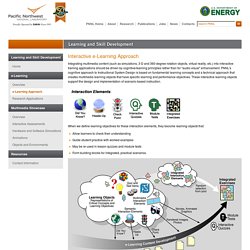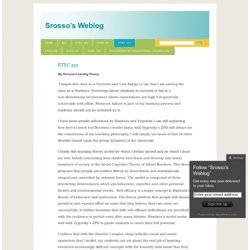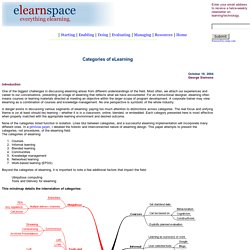

Advanced Distributed Learning. Engage Rapid Elearning. 3 Things to Consider When Building Your E-Learning Courses. The difference between effective and ineffective elearning is how you design the learning process.

In this post, I’ll do a quick run through of some ideas centered on instructional design and three things that you want to consider when building your courses. Focus on meaning and not information We tend to equate learning with sharing information. Typically if there’s something we want to change, we think about how to get more information to people. In fact, most of the elearning courses I see are focused exclusively on sharing information. If you’ve been reading this blog for a while, then the following point won’t come as a surprise. We need to take the information and then package it in a way that allows the learner to use it. When I was a young (and thin) video producer, I had to submit my projects for a peer review every Friday. Through those peer reviews I learned that my job wasn’t to give people information.
Build Effective E-Learning Courses Using These Simple Tips. In December, LINGOs announced the first global giveback campaign, which paired elearning developers with humanitarian organizations that needed some elearning courses produced.

Like many of you, David Anderson and I took up the challenge and volunteered to create a course for Christian Aid. For this project, we had no budget with limited time and resources. So I thought I’d share a little about how we built the course and some of the decisions we made because they’re common to many rapid elearning courses. Check out the course we built and then look at my notes below.
Click here to view the Christian Aid demo. Course Structure We only had a couple of weeks to work on the course. Information track: Some people just want information and prefer a linear flow. Essentially both tracks were the same; they just presented the information in slightly different ways, giving the learner some options and freedom in navigation. Dry Content? eLearning@HKBU. Social Media & Web 2.0 for Learning (2nd Edition)
Cognitive Informatics - Interactive e-Learning Approach. Integrating multimedia content (such as simulations, 3-D and 360-degree rotation objects, virtual reality, etc.) into interactive training applications should be driven by cognitive/learning principles rather than for "audio-visual" enhancement.

PNNL's cognitive approach to Instructional System Design is based on fundamental learning concepts and a technical approach that creates multimedia learning objects that have specific learning and performance objectives. These interactive learning objects support the design and implementation of scenario-based instruction. When we define learning objectives for these interaction elements, they become learning objects that: Allow learners to check their understanding Guide student practice with worked examples May be re-used in lesson quizzes and module tests Form building blocks for integrated, practical scenarios.
Distinctive features of our cognitive approach include: Aquaculturepda - Elearning. Srosso's Weblog. My Personal Learning Theory: I began this class as a Nurturer and I am happy to say that I am ending the class as a Nurturer.

Nurturing allows students to succeed or fail in a non-threatening environment where expectations are high but generally achievable with effort. However, failure is part of the learning process and students should not be defeated by it. I have been greatly influenced by Bandura and Vygotsky. I am still exploring how best to teach but Bandura’s model along with Vygotsky’s ZPD will always be the cornerstone of my teaching philosophy.
Clearly this learning theory model by which I define myself and on which I base my own beliefs concerning how children best learn and develop into moral members of society is the Social Cognitive Theory of Albert Bandura. A group project on Constructivism : A very worthy experience. Crash Course - Social Media & Web 2.0 for Learning. Welcome to this ’Crash Course’ (still under construction) to get you started with social media and web 2.0 for learning and teaching. Today there are thousands of exciting learning tools to explore, but sadly most teachers do not have the time to explore all, or figure out which ones to use. Categories of eLearning.gif (866×556)
Elearning_ecosystem.jpg (2133×1600) Elearning_cmap.jpg (1024×669) E-learning-final-draft1.jpg (3350×1908) Everything elearning: eLearning Categories. Categories of eLearning October 18, 2004 George Siemens Introduction One of the biggest challenges in discussing elearning arises from different understandings of the field.

Most often, we attach our experiences and career to our conversations, presenting an image of elearning that reflects what we have encountered. For an instructional designer, elearning often means courses or learning materials directed at meeting an objective within the larger scope of program development. A danger exists in discussing various segments of elearning: paying too much attention to distinctions across categories. None of the categories listed function in isolation. E-learning_framework4_fs.jpg (784×870) Computvir.gif (532×402) Cognitive Informatics - e-Learning Applications. Pacific Northwest National Laboratory (PNNL) Cognitive Informatics research and development in learning and skill development includes areas of application aimed at developing technology-based solutions to facilitate learning and cognitive skill development, creating innovative approaches to interactive assessment, and supporting the development and delivery of online training. e-Learning for Security Inquiry Officials Because security threats continually change, security inquiry officials need to employ high-level cognitive skills and problem-solving.

Traditional training approaches focus on memorizing facts and procedures, which tends to produce learners who know the right answers but who do not understand the relevance of the facts or the underlying concepts required to solve new problems. In contrast, teaching by problem-solving uses real-world contexts that require the learner to actively apply knowledge. OPSEC for Control Systems. Training Solutions-Online. Staff page - Centre for Learning and Research in Higher Education - The University of Auckland. E-learning - elearning model framework distance education blended learning. Everything elearning: eLearning Categories.